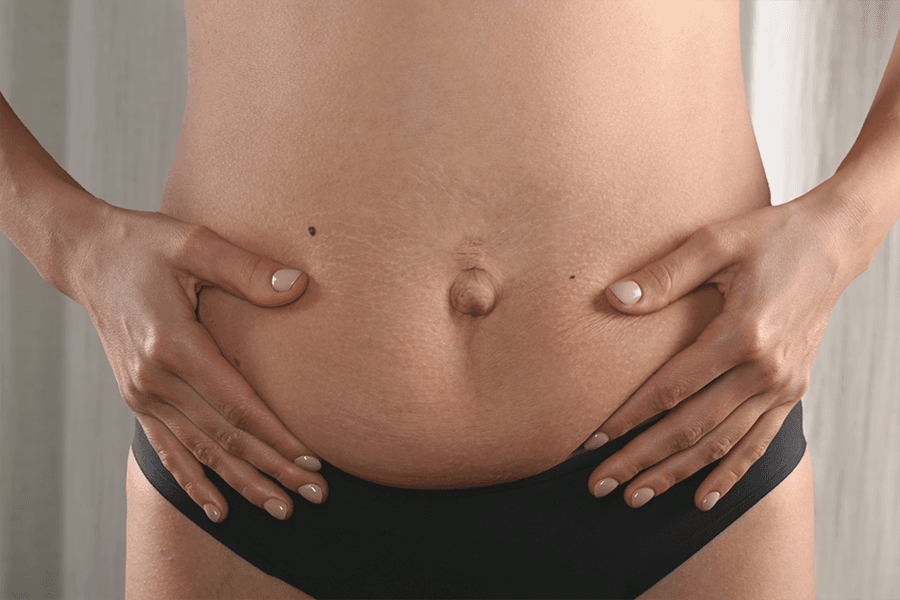During pregnancy, the stomach gradually expands to make place for the growing child in the uterus. This is called Diasta; the term describes the space between the rectus abdominis or the two abdomen muscles in the middle of the stomach. The two straight abdomen muscles are connected in the middle through a tendon called linea alba. This tendon is normally around 1-2 cm wide along its whole length, from the chest bone to the pubic bone.
During pregnancy, this tendon gets stretched out together with all the other stomach muscles. There is, however, no separation or damage on any muscle when the space increases, which is why the term “abdominal muscle separation” sometimes sounds unnecessarily frightening. At the end of pregnancy, all women will have diastasis recti, so it is a completely normal and harmless process enabling the uterus and child to grow. Many pregnant women experience the increased space between the muscles as an unevenness when doing physical activity. This can, for instance, be when you rise from a chair where you have been tilted backwards.
Stomach Exercise During Pregnancy
You can continue exercising your stomach muscles during the entire pregnancy, but it will likely be more and more difficult to control and use the muscles the bigger the stomach gets. The training should never be uncomfortable or painful and not give rise to unevenness in the middle of the stomach since that would imply the training is too heavy for what the structures in your stomach can cope with. However, there is no danger in case this may occur. Training during pregnancy neither increases nor decreases the risk for diastasis recti after birth.
Diastasis Recti after Birth
During the first year after the pregnancy, it is very normal to have an increased space between the straight abdomen muscles, but it does not mean that you always will have issues from your diastasis recti. You may still experience symptoms from a diastasis recti such as instability and decreased strength in the abdomen leading to decreased functionality. Most women, however, don’t experience any symptoms at all despite the increased space. The linea alba and the stomach muscles recover slowly after pregnancy, taking up to a year. Therefore, the space is rarely something you need to worry about or measure after the pregnancy. How the stomach functions when activated and under pressure is more important.
Training during Diastasis Recti
Earlier, the common wisdom was that training after pregnancy should be performed with caution and low pressure. The latest scientific research now, however, hints towards the opposite. In order to regain good function and durability in the stomach, all the stomach muscles need to be trained. This means you can start training your stomach even if you still have a diastasis recti. Exercises such as pushups and the plank are no longer “banned” but rather important to build up the strength in the stomach. However, it is recommended to start with smaller exercises and successively build up the pressure and build up your level. The exercises shall always feel okay and be done with good routines and control.
Help and Advice
A physiotherapist or naprapath with women’s health competencies can help you if you need individual support with your training or have questions regarding diastasis recti.
Sources:
- Michalska et al. 2018. Diastasis recti abdominis – a review of treatment methods.Thabet & Alsheri. 2019. Efficacy of deep core stability exercise program in postpartum women with diastasis recti abdominis: a randomised controlled trial.
- Mota et al. 2015. Prevalence and risk factors of diastasis recti abdominis from late pregnancy to 6 months postpartum, and relationship with lumbo-pelvic pain.
- Mota et al. 2015. The Immediate Effects on Inter-rectus Distance of Abdominal Crunch and Drawing-in Exercises During Pregnancy and the Postpartum Period.
- Carlstedt et al. 2020. Management of diastasis of the rectus abdominis muscles: Recommendations for Swedish National Guidelines.
- Beer et al. 2009. The normal width of the linea alba in nulliparous women.
- Sperstad et al. 2016. Diastasis recti abdominis during pregnancy and 12 months after childbirth: prevalence, risk factors and report of lumbopelvic pain.
- Davenport et al. 2019. Impact of prenatal exercise on maternal harms, labour and delivery outcomes: a systematic review and meta-analysis.
